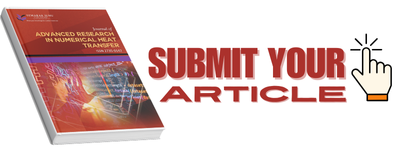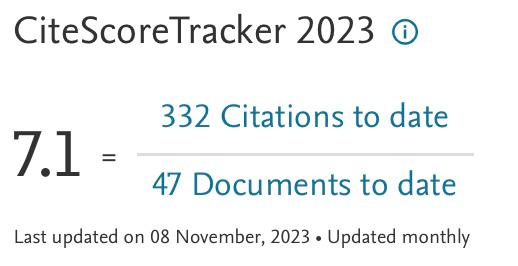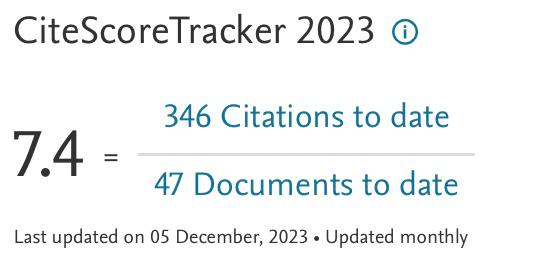Modeling and Simulation of Drilling Gas Mixing Process with Various Conditions in Oil and Gas Pipeline Network
DOI:
https://doi.org/10.37934/arnht.21.1.3952Keywords:
Gas drilling, Mixing process, Fluid dynamicAbstract
This research aims to model and simulate the gas drilling mixing process with various conditions in the inlet gas flow. This mixing process is very crucial because it can affect the phase stability in the storage tank. Based on this, the gas that has been mixed must be ensured that it is in a perfectly mixed condition before entering the storage tank. The simulation method used in this research is Computational Fluid Dynamics (CFD) with ANSYS Fluent software. The data used as input in this simulation includes flow velocity, temperature, pressure and drilling gas composition. The simulation results are expected to show that flow velocity and pressure have a significant effect on the drilling gas mixing process in the pipe flow. In addition, the differences in the composition of the drilling gas also have an impact on the mixing process, where the more diverse the composition of the drilling gas, the more difficult it is to mix the gas homogeneously. However, by using baffle plates as a barrier and agitator in the pipe, the simulation results show that the mixing of drilling gas can be significantly increased.
Downloads
References
Melaina, Marc W., Michael Penev, and Jarett Zuboy. “Hydrogen Blending in Natural Gas Pipelines.” Handbook of Clean Energy Systems (2015): 1–13. https://doi.org/10.1002/9781118991978.hces205.
Voutsas, Epaminondas, Nefeli Novak, Vasiliki Louli, Georgia Pappa, Eirini Petropoulou, Christos Boukouvalas, Eleni Panteli, and Stathis Skouras. “Thermodynamic Modeling of Natural Gas and Gas Condensate Mixtures.” Natural Gas Processing from Midstream to Downstream (2018): 57–88. https://doi.org/10.1002/9781119269618.ch3.
Zhang, Geng, Jun Li, Hongwei Yang, Gonghui Liu, Qin Pang, Tong Wu, and Honglin Huang. “Simulation research on solid fluidization exploitation of deepwater superficial layer natural gas hydrate reservoirs based on double-layer continuous pipe.” Journal of Natural Gas Science and Engineering 108, (2022): 104828. https://doi.org/10.1016/j.jngse.2022.104828.
Li, Guoqing, Kai Zheng, Shimao Wang, and Wenzhuo Chen. “Comparative study on explosion characteristics of hydrogen and gasoline vapor in a semi-confined pipe based on Large Eddy Simulation.” Fuel 328, (2022): 125334. https://doi.org/10.1016/j.fuel.2022.125334.
Wu, Lei, Jun Zhou, Jingjing Zhou, Kun Liang, Yonghui Song, Q. Zhang, and Yuhong Tian. “Temperature-rising characteristics and product analysis of low-rank coal microwave pyrolysis under CH4 atmosphere.” Journal of Analytical and Applied Pyrolysis 141, (2019): 104632. https://doi.org/10.1016/j.jaap.2019.104632.
Shiehnejadhesar, Ali, Robert Scharler, Ramin Mehrabian, and Ingwald Obernberger. “Development and validation of CFD models for gas phase reactions in biomass grate furnaces considering gas streak formation above the packed bed.” Fuel Processing Technology 139, (2015): 142–158. https://doi.org/10.1016/j.fuproc.2015.07.029.
Feldmann, F., B. Hagemann, L. Ganzer, and M. Panfilov. “Numerical simulation of hydrodynamic and gas mixing processes in underground hydrogen storages.” Environmental Earth Sciences 75, (2016): 1–15. https://doi.org/10.1007/s12665-016-5948-z.
Wang, Cheng, Jian Lv, Jeffrey A. Coulter, Jianming Xie, Jihua Yu, Jing Li, Jing Zhang, Chaonan Tang, Tianhang Niu, and Yantai Gan. “Slow-release fertilizer improves the growth, quality, and nutrient utilization of wintering Chinese chives (allium tuberosum rottler ex spreng.).” Agronomy 10, (2020): 381. https://doi.org/10.3390/agronomy10030381.
Lee, Dong Hee, In Jun Jeong, and Kwang Jae Kim. ”A desirability function method for optimizing mean and variability of multiple responses using a posterior preference articulation approach.” Quality and Reliability Engineering International 34, (2018): 360–376. https://doi.org/10.1002/qre.2258.
Liu, Li, Yang Li, and Shisuo Fan. “Preparation of KOH and H3PO4 modified biochar and its application in methylene blue removal from aqueous solution.” Processes 7, no 12 (2019): 891. https://doi.org/10.3390/PR7120891.
Lu, Yao, Guo-sheng Li, Yong-chao Lu, Xing Fan, and Xian-yong Wei. “Analytical Strategies Involved in the Detailed Componential Characterization of Biooil Produced from Lignocellulosic Biomass.” International Journal of Analytical Chemistry 2017, (2017): 9298523. https://doi.org/10.1155/2017/9298523.
Kusumaningtyas, Ratna Dewi, Haniif Prasetiawan, Brylian Rizky Pratama, Dani Prasetya, and Anwaruddin Hisyam. "Esterification of non-edible oil mixture in reactive distillation column over solid acid catalyst: Experimental and simulation study." Journal of Physical Science 29 (2018): 215-226. https://doi.org/10.21315/jps2018.29.s2.17.
Yee, C.S., H. Prasetiawan, A. Hisyam, A. Azahari, and I.H. Maharon. 2015. Sensitivity study of the propane dehydrogenation process in an industrial radial moving bed reactor. Journal of Engineering Science and Technology 10, (2015): 62 – 74.
Triwibowo, B, H W Widayanti, and M I Rukmanasari. “Prediction of Erotion Rate in Two Elbows for Coal-Air Flow Based on Computational Fluid Dynamics Simulation.” Journal of Advanced Research in Fluid Mechanics and Thermal Sciences 97 no. 2, (2022): 115–125. https://doi.org/10.37934/arfmts.97.2.115125.
Ibrahim, Gusri Akhyar, Wahyu Hidayat, Agus Haryanto, and Udin Hasanudin. "Laporan Pengabdian Kepada Masyarakat Desa Binaan Universitas Lampung: Pelatihan Pembuatan Biochar Dari Limbah Biomassa Jagung Menggunakan Metode Kon Tiki Dan Drum Retort Kiln." (2021).
Said, M., W. Septiarty., and T. Tutiwi. “Studi Kinetika Reaksi pada Metanolisis Minyak Jarak Pagar.” Jurnal Teknik Kimia 17, no. 1 (2010): 15–22.
Wibowo, Wusana Agung, Rochim Bakti Cahyono, Rochmadi, and Arief Budiman. “Thermogravimetric Analysis and Kinetic Study on Catalytic Pyrolysis of Rice Husk Pellet using Its Ash as a Low-cost In-situ Catalyst.” International Journal of Renewable Energy Development 11, no. 1 (2022): 207–219. https://doi.org/10.14710/IJRED.2022.41887.
Wijayanti, Widya, Musyaroh, Mega Nur Sasongko, Rizky Kusumastuti, and Sasmoko. “Modelling analysis of pyrolysis process with thermal effects by using Comsol Multiphysics.” Case Studies in Thermal Engineering 28, (2021): 101625. https://doi.org/10.1016/j.csite.2021.101625.
Triwibowo, B, H W Widayanti, and M I Rukmanasari. “Prediction of Erotion Rate in Two Elbows for Coal-Air Flow Based on Computational Fluid Dynamics Simulation.” Journal of Advanced Research in Fluid Mechanics and Thermal Sciences 97 no. 2, (2022): 115–125. https://doi.org/10.37934/arfmts.97.2.115125.
Triwibowo, B., H. Prasetiawan, A. Hisyam, M.F. Fauzan, and M.H.F. Rizky. “Modeling and simulation of steady state model approach for horizontal three phase separator (HTPS).” AIP Conference Proceedings. 1818, (2017): 4976926. https://doi.org/10.1063/1.4976926.
Debtera, Baru. “Computational Fluid Dynamics Simulation and Analysis of Fluid Flow in Pipe: Effect of Fluid Viscosity.” SSRN Electronic Journal (2022): 1–15. https://doi.org/10.2139/ssrn.4201717.
Wrzesień, S., Paweł Madejski, and Paweł Ziółkowski. “Computational Fluid Dynamics Simulation of Gas – Liquid Multiphase Flow in T-junction for CO2 Separation.” Zeszyty Energetyczne VII (2020): 403–414.
Tan, Kun, Devinder Mahajan, and T. A. Venkatesh. “Computational fluid dynamic modeling of methane-hydrogen mixture transportation in pipelines: Understanding the effects of pipe roughness, pipe diameter and pipe bends.” International Journal of Hydrogen Energy 49, part D (2024) 1028 – 1042. https://doi.org/10.1016/j.ijhydene.2023.06.195.
Liang, Chengyu, Wei Xiong, and Zhiwen Wang. “Flow characteristics simulation of concave pipe with zero net liquid flow.” Energy Reports 8 (2022): 775–782. https://doi.org/10.1016/j.egyr.2022.09.162.
Van Berkel, J. T., G. Deinum, and T. L. Mason. “Blending optimization of contaminated gas in a miscible gasflood.” International Petroleum Technology Conference 2007, IPTC 2007 3 (2007): 1387–1396. https://doi.org/10.3997/2214-4609-pdb.147.iptc11613.
Wang, Huamin, Jonathan Male, and Yong Wang. “Recent advances in hydrotreating of pyrolysis bio-oil and its oxygen-containing model compounds.” ACS Catalysis 3 (2013): 1047–1070. https://doi.org/10.1021/cs400069z.




























